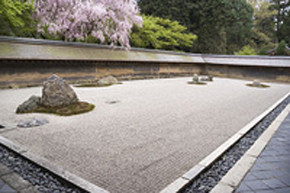

A recurring and mysterious concept in Japanese culture, the “space between things” is the topic of a book by Michiko Okano, professor at the Universidade Federal de São Paulo (Wikimedia)
A recurring and mysterious concept in Japanese culture, the “space between things” is the topic of a book by Michiko Okano, professor at the Universidade Federal de São Paulo
A recurring and mysterious concept in Japanese culture, the “space between things” is the topic of a book by Michiko Okano, professor at the Universidade Federal de São Paulo

A recurring and mysterious concept in Japanese culture, the “space between things” is the topic of a book by Michiko Okano, professor at the Universidade Federal de São Paulo (Wikimedia)
By José Tadeu Arantes
Agência FAPESP – The word Ma became more widely known outside the Japanese cultural world after the exhibition Ma, Espace-Temps du Japon, held at the Louvre in 1978. Understanding its meaning, however, continues to be a challenge for the Western mind, which identifies with things. This difficulty occurs precisely because Ma is not a thing but a space between things.
It is present in every instant of existence but is rarely considered in the Western world except by certain geniuses in literature and the arts, such as Clarice Lispector, who wrote in her book “Perto do coração selvagem” that “between the hand and objects, there is something beyond air.”
A deeper study of the topic is now available to Brazilian readers in the book “Ma: entre-espaço da arte e comunicação no Japão” (Ma: the between-space of art and communication in Japan) by Michiko Okano, published with FAPESP funding and additional support from Fundação Japão.
Okano was born in Japan and learned to read there; she has lived in Brazil since she was 8 and is currently an Asian art history professor at the Art History Department of Universidade Federal de São Paulo (Unifesp). She believes that her existential trajectory woven in the negative space of two cultures is an expression of Ma.
“Ma, this intermediary space in which the new can be generated, is not unique to Japanese culture. What is unique is its appreciation,” comments the researcher in an interview with Agência FAPESP.
Ma is found in a countless number of Japanese cultural expressions: the distance that people should maintain between each other for traditional greetings, respectfully bowing one’s head; the narrative pauses in which the camera pauses on objects and landscapes in the celebrated films of Ozu Yasujiro (1903-1963), considered the “most Japanese” of the leading Japanese film makers; the space that should be kept between portions of food in the composition of a typical dish; and genkan, the entry hall of a residence, where people take off their shoes as a rite of passage between public and private space.
These and many other expression of Ma are covered in refined detail in Okano’s book. “It is not the mere intermediary space but a space where something new can emerge,” explained the professor. “In the traditional view, it is an intermediary space where the Divine can manifest at any moment, establishing new feeling.”
The polysemy of Ma lies precisely in its uncertainty. Because it is not a thing, it could become a field for manifestation of anything. In this case, the same affirmation made by writer Fernando Pessoa in relation to the myth is valid: “nothing is everything.” In a less serious manner, the researcher noted that she always jokes with her students, saying that “a person without a girlfriend or boyfriend has available space, or, rather, could theoretically have any girlfriend or boyfriend.”
Found in the ancient Shintoist culture, well before Buddhism in Japan (most likely in the 6th century A.D.), the notion of Ma was later highly appreciated and refined in the context of Zen Buddhism, with its minimal essential aestheticism.
One famous example cited by Okano is the stone and sand garden at the Ryoan-ji temple in Kyoto. “It is a space with few elements, formed by 15 stones placed in a very peculiar manner over the sand base. No matter where a person sits, s/he cannot see all 15 stones at once.”
“The silent and sparse garden is a pure expression of Ma and an instrument of meditation,” she continues. “And the meditation itself is Ma because it ‘empties itself’ in a ‘non-thinking,’ but not a ‘thinking about not thinking,’ which would becomes thinking itself, therefore simply a ‘let thought flow’ without following it.”
In another cultural key, Brazilian contemporary architecture brilliantly incorporated the creative emptiness into its solutions, as seen in the canopy of Ibirapuera Park, projected by Oscar Niemeyer (1907-2012). With its irregular format, approximately 620 meters in length and varying between 15 and 80 meters, this huge intervalic space is much more than a covered walkway between different buildings. The ways in which it is used have proven as unpredictable as the imaginations of the park’s visitors.
In addition to the quality of unpredictability, this flighty and incomprehensible nature is one of the major characteristics of Ma. For this reason, a Kabuki actor affirmed that there is a teachable Ma and another that is unteachable. This mysterious quality, which cannot be translated into words, makes the difference between a major work of art and mere imitation.
Republish
The Agency FAPESP licenses news via Creative Commons (CC-BY-NC-ND) so that they can be republished free of charge and in a simple way by other digital or printed vehicles. Agência FAPESP must be credited as the source of the content being republished and the name of the reporter (if any) must be attributed. Using the HMTL button below allows compliance with these rules, detailed in Digital Republishing Policy FAPESP.





